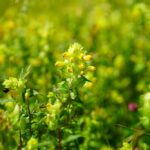We use cookies to make your experience better. To comply with the new e-Privacy directive, we need to ask for your consent to set the cookies. Learn more.
Yellow Rattle

Yellow rattle (Rhinanthus minor) has beautiful gold flowers and is a valuable wildflower, but it is also famous for its ability to reduce the vigour of grass. The plant operates as a partial parasite on grasses, it will lock its roots onto the roots of grasses, once contact is made the yellow rattle draws water and nutrients from them, suppressing the growth of grasses by up to 60%. Therefore giving other flowers more room to grow. It is an annual species which germinates in the spring, flowers in summer and sets seed around late August. Yellow Rattle works well in existing meadows or in large areas that are mainly grass where complete removal of grasses and weeds would be difficult.
Establishing Yellow Rattle
- After carrying out Autumn maintenance of the meadow, i.e cutting and clearing away the dried material, scarify or harrow the area to open up some bare soil for the seed.
- Yellow rattle seeds are very short lived (18-24 months) and must be sown as fresh as possible.
- Sow from Autumn until the end of November, seed needs to be exposed to an extended cold period before it will germinate. Seed sown after Christmas germinates poorly.
- Sow at a rate of 0.5g - 1g per square meter. Best to sow in small areas rather than broadcast.
- Seedlings will begin to appear in spring, from late March through to May. Don’t be worried if only a few plants germinate in the first year. They’ll grow and shed their own seed and numbers should increase rapidly.
- The flowers of yellow rattle are pollinated by large bees (especially bumblebees) and are followed by large, inflated seed pods. When these ripen and dry, the seed inside rattles around; in former times, farmers used this sound as their cue to cut the hay.
- The flowering period of Yellow Rattle is quite short and usually peaks in June. Plants are normally about ankle height and produce a mass of small Yellow flowers, which carpet meadows in early summer and attract bees. By July most Yellow Rattle plants have died back and quickly turn brown, leaving a distinctive and attractive papery seed head.
Maintaining Yellow Rattle
- Yellow Rattle is an annual plant so has to be managed carefully for it to successfully self-seed. If the meadow is cut too early the plants can be damaged and will fail to flower and produce seed. In meadows that already contain other wild flowers in addition to Yellow Rattle, traditional advice is to perform several spring cuts, which can lead to problems if the cutting height is too low. Try to identify the Yellow Rattle seedlings as soon as possible and ensure that patches are either avoided or cutting machinery is set to a greater height than that of the Yellow Rattle plants.
- Yellow rattles upright growth habit make it intolerant of mowing, so don't cut your flower meadow until plants have reached maturity and set seed. This will increase their establishment in the following years.
- Once yellow rattle is established, you don’t need to scarify the soil each year, just cut the meadow really hard once the seed has been shed and remove the hay or clippings. This can be any time from late July or preferably into August or early September, allowing late-blooming plants to provide food for pollinators and shed their seed.
- If your soil is very fertile you might struggle to keep yellow rattle going – it can slowly disappear. Wildflower meadows do best on poor, infertile soils. If you find that your yellow rattle is overtaking - you can mow early in the season (May/June) to prevent the plants from seeding.

